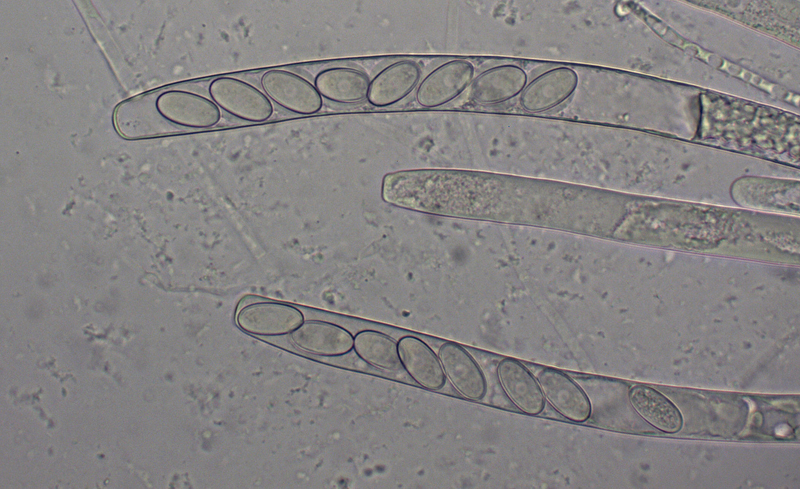Map Snapshot





9 Records
Description
Fruiting body: Up to 6" (15 cm); cup-shaped when young to broad in maturity; margin often split/ragged; flesh brownish, brittle; central attachment to substrate. Fertile (interior) surface brown, smooth to wrinkled; infertile (outer) surface: white to light brown with pale hairs.
Where To Find
Solitary/groups on rotting hardwoods; occasionally on wood chips or ground with decaying wood.
Seasonality Snapshot
Source: Wikipedia
| Peziza varia | |
|---|---|

| |
| Scientific classification | |
| Domain: | Eukaryota |
| Kingdom: | Fungi |
| Division: | Ascomycota |
| Class: | Pezizomycetes |
| Order: | Pezizales |
| Family: | Pezizaceae |
| Genus: | Peziza |
| Species: | P. varia
|
| Binomial name | |
| Peziza varia Hedw. (1789)
| |
| Synonyms | |
|
Peziza repanda Pers. (1808) | |
| Peziza varia | |
|---|---|
| Smooth hymenium | |
| Hymenium attachment is not applicable | |
| Lacks a stipe | |
| Spore print is white to cream | |
| Ecology is saprotrophic | |
| Edibility is inedible | |
Peziza varia, commonly known as the spreading brown cup fungus,[1] Palomino cup or recurved cup, is a species of fungus in the genus Peziza, family Pezizaceae.
Description
[edit]
Peziza varia can be identified by its growth on rotted wood or wood chips, its brown upper surface (at maturity) that is usually somewhat wrinkled near the center; a whitish and minutely fuzzy under surface; a round, cuplike shape when young, and a flattened-irregular shape when mature; attachment to the wood under the center of the mushroom, rather than under the whole cup; thin, brittle flesh (rather than thick and gelatinous) and smooth, elliptical spores that lack oil droplets.[2]
The cup at first is pale brown or whitish overall, the under surface minutely fuzzy and the upper surface smoother, with a tiny stem-like structure. In maturity it is flattened-irregular or bent backwards, 2–12 cm across,[3] the margin often splitting, upper surface brown and smooth, often "pinched" or somewhat wrinkled over the center, under surface whitish and minutely fuzzy, attached to the substrate centrally, without a stem. It has no odor. The flesh is brownish or pale, and brittle.[2]
Peziza means a sort of mushroom without a root or stalk.[4]
Microscopic features: Spores 11–16 x 6–10 μm; smooth; elliptical; without oil droplets. Asci eight-spored; up to 225 x 15 μm.[2]
Similar species
[edit]Similar species include Peziza arvernensis, P. domiciliana, P. vesiculosa, and P. violacea.[3]
Peziza repanda, Peziza cerea and Peziza micropus are synonyms.[5]
Ecology
[edit]Well decayed logs may sport the Palomino cup fungus, which is saprobic, usually on the wood of hardwoods. Soil rich in decayed wood and occasionally that which is covered with wood chips may support Palomino cup; growing alone, gregariously, or in clusters. This member of the cup fungi is commonly found in colder weather (spring and autumn in temperate regions), but sometimes appearing in summer.[2]
Edibility
[edit]Peziza varia is nonpoisonous[6] but inedible.[7]
Distribution
[edit]Peziza varia is widely distributed throughout America and Europe.
References
[edit]- ^ Arora, David (1986). Mushrooms demystified: a comprehensive guide to the fleshy fungi (Second ed.). Berkeley: Ten Speed Press. ISBN 978-0-89815-169-5.
- ^ a b c d Mushroom Expert website
- ^ a b Davis, R. Michael; Sommer, Robert; Menge, John A. (2012). Field Guide to Mushrooms of Western North America. Berkeley: University of California Press. pp. 399–400. ISBN 978-0-520-95360-4. OCLC 797915861.
- ^ Fungus species website
- ^ Hansen, Karen; Læssøe, Thomas; Pfister, Donald H. (2002). "Phylogenetic diversity in the core group of Peziza inferred from ITS sequences and morphology" (PDF). Mycological Research. 106 (8): 879–902. doi:10.1017/S0953756202006287. ISSN 0953-7562. S2CID 54010289. Retrieved 2021-12-13.
- ^ Miller Jr., Orson K.; Miller, Hope H. (2006). North American Mushrooms: A Field Guide to Edible and Inedible Fungi. Guilford, CN: FalconGuides. p. 538. ISBN 978-0-7627-3109-1.
- ^ Roger Philip's Mushrooms Archived 2008-07-08 at the Wayback Machine
External links
[edit]- Spore release
- Wild about Britain
 Data related to Pezizaceae at Wikispecies
Data related to Pezizaceae at Wikispecies








